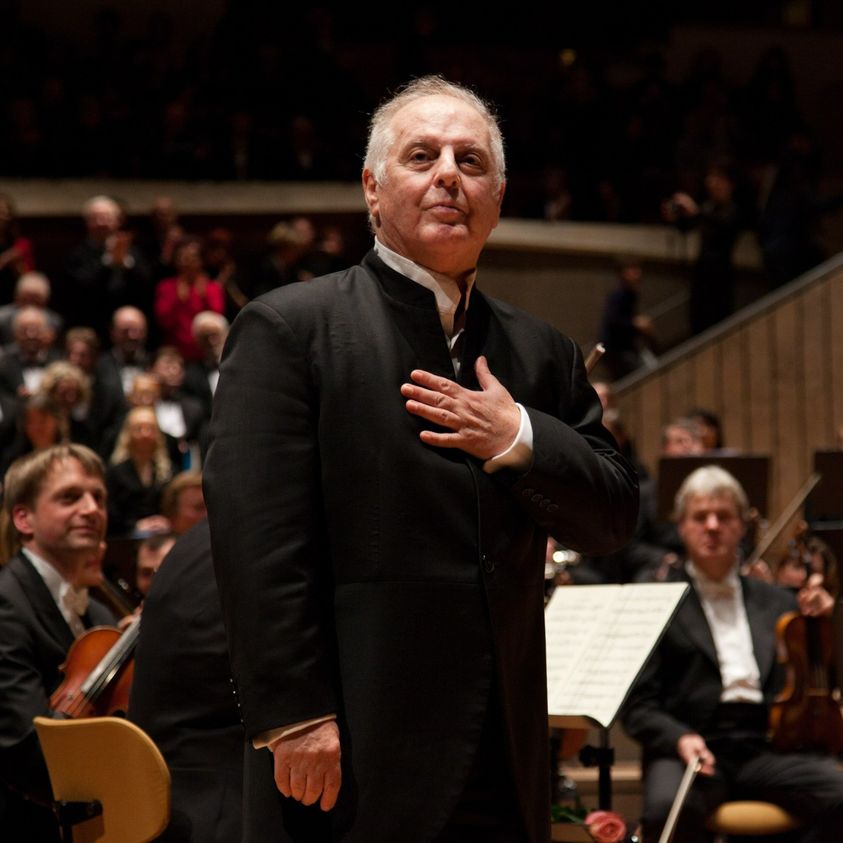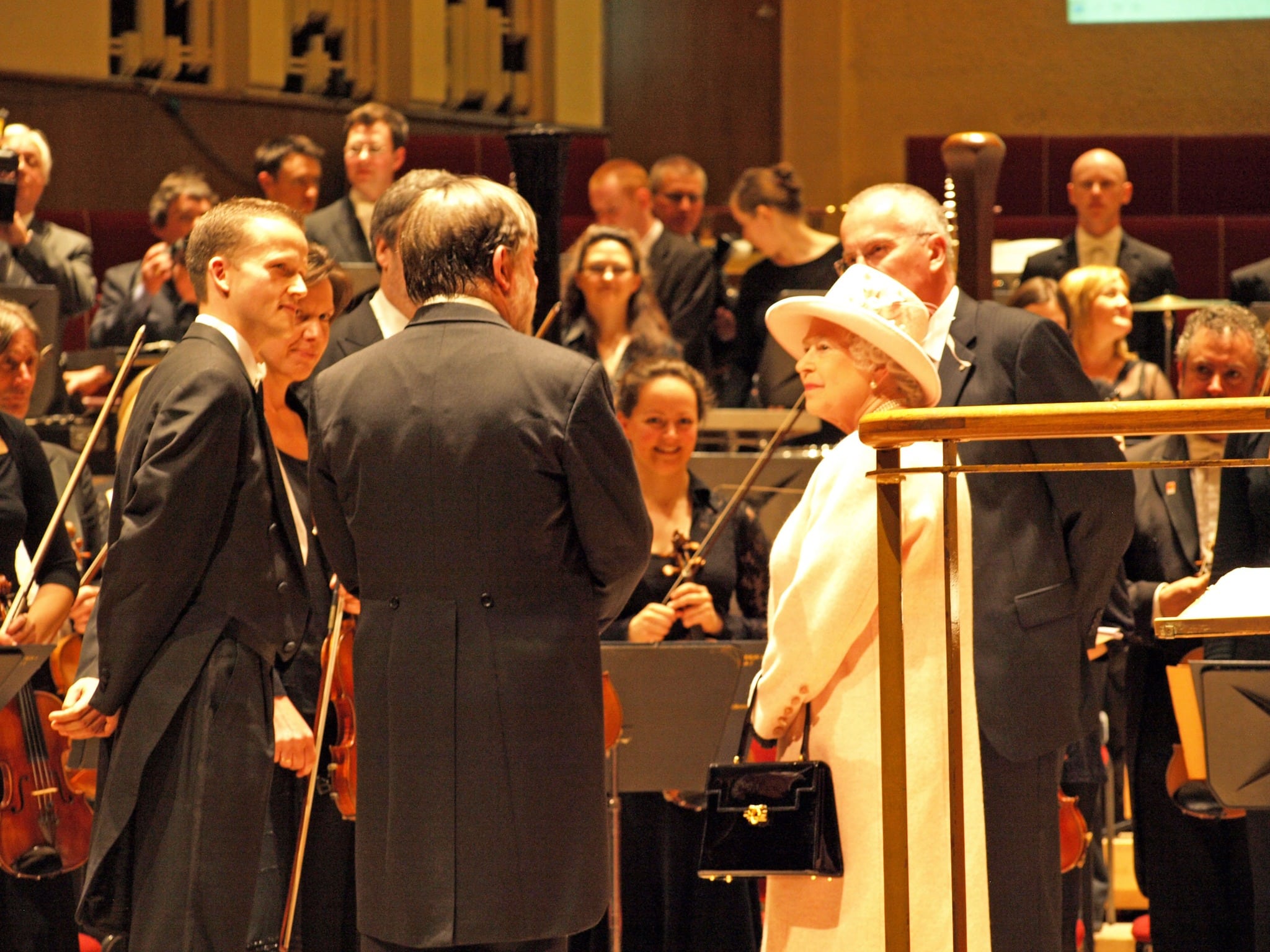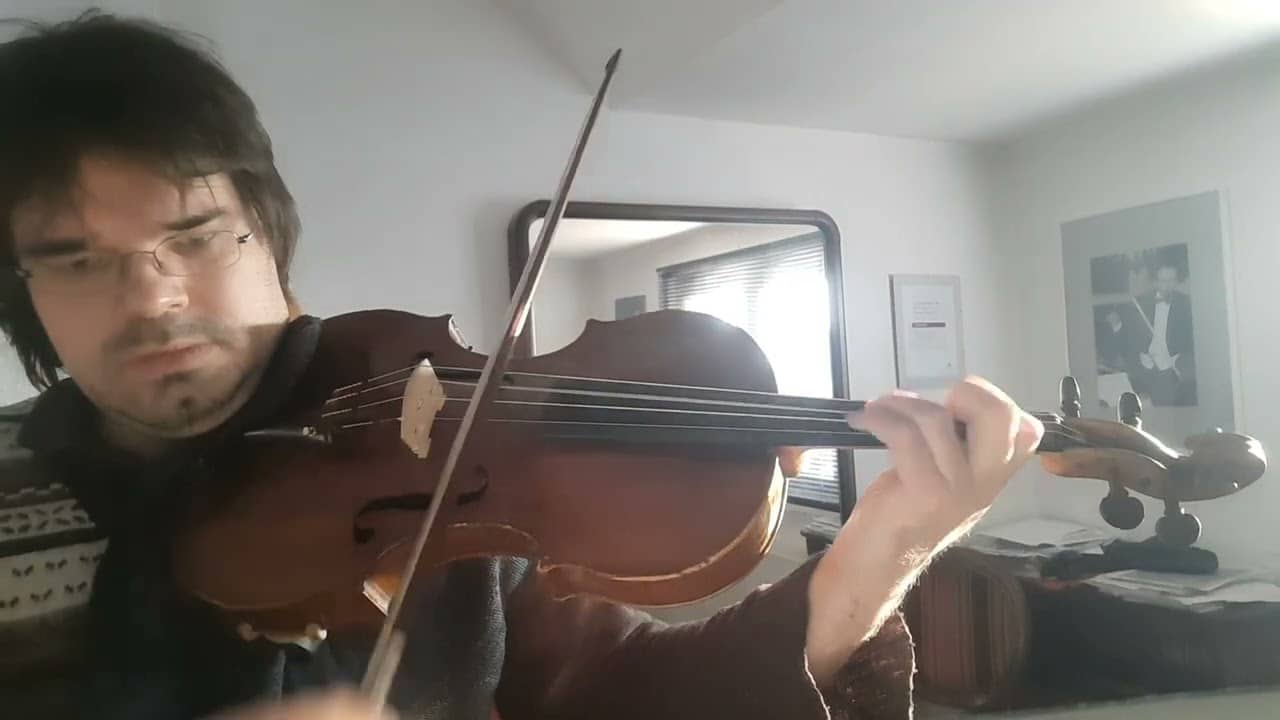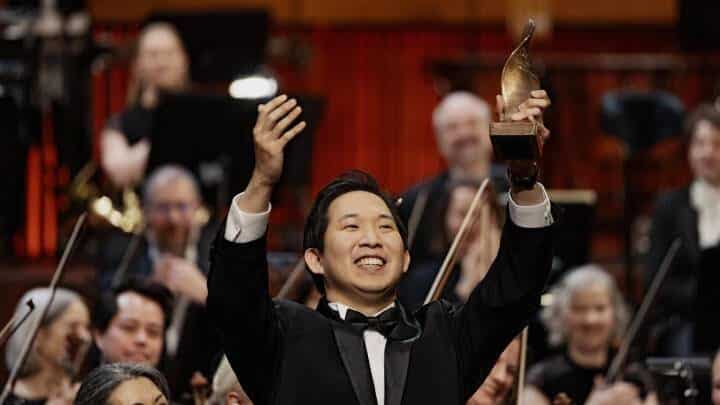Mahler’s most performed symphony gets a critical makeover
NewsUniversal Edition has produced a critical edition of Gustav Mahler’s fourth symphony, incorporating changes he made to galley proofs in February 1911, weeks before his fatal illness. The proofs somehow went lost until lately.
The edition also takes in marks on Mahler’s own conducting score from 1905.
Renate Stark-Voit explains:
UE says: ‘There are hundreds and hundreds of details that – taken as a whole – make a thoroughly astonishing difference.’
No announcement yet of a performance of the cleaned-up score. Most orchestras will stick to the out-of-copyright score in their libraries.






“There shall, in that time, be rumours of things going astray, erm, and there shall be a great confusion as to where things really are, and nobody will really know where lieth those little things with the sort of raffia work base that has an attachment. At this time, a friend shall lose his friend’s hammer and the young shall not know where lieth the things possessed by their fathers that their fathers put there only just the night before, about eight o’clock. Yea, it is written in the book of Cyril that, in that time, shall the third one…”
Not the third, Gustavo. It’s the fourth.
Edition?
Even with a composer as meticulous as Mahler should edits made weeks before he died be taken as seriously as those when he was in better health? Given the central subject of the 4th symphony, it seems to be a particularly apt question.
If you’re trying to get rental fees and royalties on otherwise PD works, the answer is yes. 😉
Uh-huh.
“But for you… Only €99,95!!”
I’ll stick with the three editions I bought in the ’70s and ’80s, thanks. Any decent librarian will just mark the (three? five?) interesting changes into the parts. Happy to read the new Revisionsbericht for free any time, though.
Whole thing is a long ongoing scam. And the new computer-age fonts make them unappealing even to look at.
No doubt, an enerprising orchestra and record label will make a recording of this new edition. There are enough Mahler fans out there for it to sell well. Hopefully, Norman will review it, if it does get released.
Look at how many versions we have of the 10th Symphony. I buy every single one of them too. We have to make at least 5 or 6 versions of every one of them.
I think it’s a case where the quality of the performance and the recorded sound, will stay make a bigger difference than minor editorial changes. I find that true with Bruckner, in spite of Bruckner fans wanting to embrace every bloody version and edition of his symphonies. Gilbert Kaplan recorded Mahler 2 a second time with the Vienna Phil. on DG. He used a new critical edition ‘urtext’ in the process. Few seem to have cared about that, and many still prefer his earlier effort with the London Symphony. Still, I would want to hear a recording of the ‘urtext’ of M4.
I’m not quite clever enough to know what Gustavo is going on about (no disrespect intended), but it’s the way music publishing is going these days – bring out new editions to keep making money. I don’t blame the publishers at all, and I’m sure the editors are clever informed musicologists who spent a lot of time doing it. But will it make any difference to performances? I doubt it very much. How else can you account for vastly different performances from the same set of parts as I have witnessed countless times.
Claudio Abbado spent the 1980’s constantly tinkering with the Mahler Symphonies (orchestration, dynamics, articulations etc.) and very few listeners had a clue, often changing things between performances.
These wonderful “new” editions also come with countless errors – I remember purchasing the new Bareinreiter Beethoven Symphonies in the 1990’s which came complete with a long list of corrections I was expected to make myself.
The representatives from publishers then target conductors and encourage them to ask for these new “revelatory” editions at the orchestras they work with. Again more power to their elbow.
Top orchestral players do not like these new editions. Their carefully kept and maintained parts have had all errors long ago corrected. The bowings for the string players are superbly crafted over countless performances. The parts have all been edited by individual players with their own individual marks.
And of course professional orchestral librarians do not like them. A whole set of Beethoven Symphonies is probably about 5000 pages of bowings which need to be marked before full rehearsals. (Try doing that in your spare time).
One of the most moving and spell-binding performances of Beethoven 9 I have ever been fortunate to hear used a set of parts that had been in continuous use since the 1930’s.
In my opinion, one of the best posts on SD in many a moon. Give me Mengelberg in Mahler 4 every time.
Not to worry, Gustavo doesn’t either.
Mahler editions are starting to get as crazy as Bruckner! UE should finance a recording: Wiener Philharmoniker and a conductor who will not intervene but play it as the new edition is written. Daniel Harding.
UE finance it!! They are rather hoping the flow of money will be to them.
“Most performed symphony”?? Not in the U.S.
I’ve heard the 1st at least twice as often as the 4th. I think the 5th gets played more often too. And the 2nd gets played on special occasions like a music director’s final concert or a season finale, so I think I’ve even heard that more than the 4th.
I was wondering about that — surely it’s the first.
Interesting – so which is the most performed in US ?
Yes, I was going to question that – the 2nd or 5th, surely?
. . . don’t call him Shirely.
Agreed. I think it’s #1.
Yeah well, but then the total number of performances in the US is negligible globally speaking. There are probably more Mahler performances in Berlin alone than in the US.
Believe it or not, there are orchestras and performances outside the United States.
The 1st is and has always been the most performed Mahler symphony. It goes down the easiest with audiences, doesn’t require a vocalist, and the players all know it well. We’re probably looking at 8 being the least performed, followed by 7, which is too bad, since it is such an incredible work of art.
One cannot help think whether this is a serious musical enterprise or a financial one.
In one of the first years of this century, I was spending a few days at the Bregenzer Festspiele. For those who don’t know, Bregenz is the summer home for the Wiener Symphoniker, just as the Philharmoniker goes to Salzburg. They both perform the same functions: play some concerts and mostly serve as pit bands.
On this particular trip I was invited to a Symphoniker concert which announced only Mahler’s Sinfonie Nr. 5. I thought there must be something else. Surprise encores? (Actually, the one and only time I heard an encore after a Mahler symphony was a sad, sad event with Barenboim/Chicago at Carnegie Hall.)
As the concert approached I learned we were going to hear the world premiere of a new critical edition prepared by Dr Reinhold Kubik of the Internationale Gustav Mahler Gesellschaft.
For about 40 minutes, Dr Kubik stood in front of the orchestra and gave a fascinating lecture about his work on the new edition. There were over 700 corrections made from consulting every available source, including Mahler’s own marked-up scores and archival material from all around Europe, including (and I find this especially fascinating) the timings of each movement when Mahler conducted it himself, including performances at the Concertgebouw.
We were treated to “before” and “after” examples of the symphony. Some of them were jaw-droppingly astounding.
We then had an intermission and the premiere of the complete new edition.
I met Kubik afterwards and discussed his projects at IGMG and the performance we just heard. I remarked that I thought the adagietto was played a bit too fast, and Kubik explained to me why he though it too slow. Using archive sources like the Concertgebouw timings, it was determined that Mahler performed it between six and seven minutes. The performance that evening had taken a bit over nine minutes. I asked about some of the legendary recordings, naming in particular HvK and the later Bernstein, both of which drag it out to about 11 minutes. Kubik said, “Anything over 10 minutes is perverse” and sent me to the Bruno Walter NYP broadcast from 1947 which clocks in at 07:35. A good example of how not to lead it can be found on James Levine’s RCA recording (Philadelphia Orchestra) which lasts over 12 minutes.
Since then, when I hear Nr 5 I can actually tell if the orchestra is using Dr Kubik’s new edition, or an older one. These things do matter, especially if you are lucky enough to have someone illustrate the significant changes for you.
I believe the Rattle/Berliner recording was the first to use the new edition. Even so, his adagietto was played at about the same tempo as the Symphoniker had in Bregenz.
I look forward to hearing the “new” Nr. 4.
And yeah – who says Nr. 4 is the most-played? Every orchestra that comes through here feels obliged to do Nr. 5, as do local student orchestras.
UE, which has held the rights since Mahler was alive, states that it it the most performed.
That assumes that every orchestra is using an edition of the scores that are still protected by copyright.
My understanding is that others have prepared their own “critical editions” using editions that are in the public domain as a starting point, such as a 2010 version of the 6th prepared by Dr Reinhold Kubik and published by Peters Edition.
Wow. That sounds fascinating. Thanks.
On Levine’s second CD, a live performance in Verbier in 2003, IV clocks in at 10:51. Does that make you happier? (Or does the :O1 part annoy you?)
People and their stopwatches….
I trust Mahler scholarship will not go the way of the Bruckner cult with multiple feuding editions of the same work.
Fascinating the disdain for critical editions that prevails in the comments here!
How sad, though, that Mahler for some reason considered it worthwhile to mark details in his scores. If only he had understood music as well as Norman’s readers, he would have spared himself all that wasted effort.
I would call it reasonable cynicism.
Most listeners will not detect many if any of the edits. But to drum up demand for the new edition, the publisher insinuates that the edits are so substantial that it’s like they found a “lost” movement.
And because orchestras will have to rent the new edition, many are going to continue to use older editions outside of copyright to save money.
That may happen, I suppose, but the cost of renting an edition is pretty trivial in the context of an orchestra’s budget. And “most listeners” will also not detect whether subs are replacing all the principal players on a given night – yet it remains important.
It’s common for regional orchestras in the US with annual budgets in the $1 million to $5 million range to reject programming a piece if it’s a rental, particularly if program it was slated for is going to be performed more than once. With so many orchestras on life support, spending money on rentals is often seen as an unaffordable luxury.
Why is the 4th so popular? Because of the song at the end? Or the adagio? The work was criticised at its premiere for being ‘faux naif’, that it was in a fake quasi 18C style, with hardly any chromaticism, which was a bit offensive for the early 20th century when so many things showed the impressive progressiveness of modern society.
But the genius of that work is that with entirely straightforward material, and a purely diatonic style, something entirely new and fresh came into being, with a mild irony that does not undermine the seriousness of the music. The quasi-simplicity is realized with very refined scoring, sometimes creating the most amazing effects with the simplest of means. One of these spots found its way in Walter Piston’s book on orchestration, as an example of highly effective and original simplicity.
Richard Strauss said of the adagio that he could not possibly write such a beautiful, long slow movement – he greatly admired it. No jealousy there.
Please stop calling it an “adagio.”
It’s “Ruhevoll (Poco adagio).” Not the same thing. These details all matter. The people who work on this care.